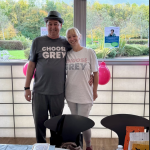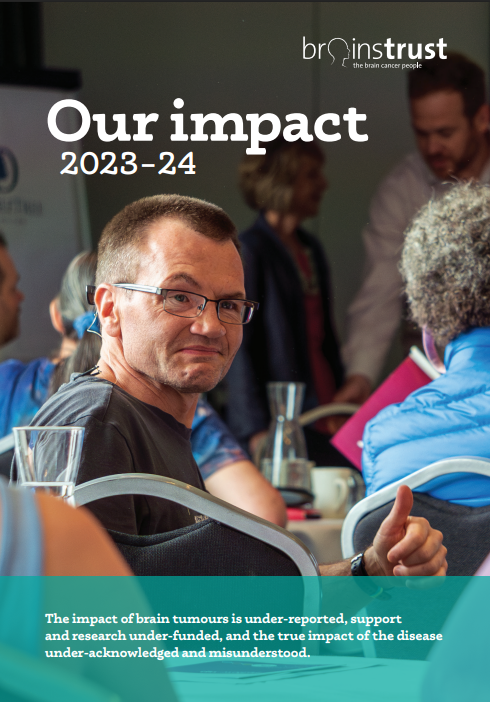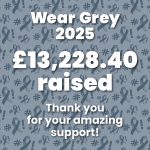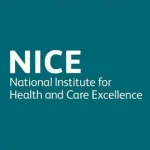Celebrating Our Wear Grey Fundraisers
This year’s Wear Grey campaign has been nothing short of extraordinary. Thanks to the incredible effort, generosity, and spirit of our community, Wear Grey 2025 raised an amazing £13,228.40! Whether you bought Wear Grey merchandise, raised awareness, made a donation, or organised a fundraiser, you helped drive real change for people living with a brain tumour. From the bottom of our hearts: thank you.
Alongside hundreds of supporters wearing grey with pride throughout Wear Grey week, several incredible individuals and groups went the extra mile to fundraise. Their passion and creativity helped fuel this year’s success.
 Susan & Ant – Workplace Fundraising Heroes. Susan and Ant brought Wear Grey to Ant’s workplace, hosting a fantastic event that brought colleagues together in support of the brain tumour community, and raised £808.00!
Susan & Ant – Workplace Fundraising Heroes. Susan and Ant brought Wear Grey to Ant’s workplace, hosting a fantastic event that brought colleagues together in support of the brain tumour community, and raised £808.00!
“We were contact by brainstrust after being referred to the by our Oncology nurse and their support and resources have been fantastic! Even sending out information booklets free of charge to us about those difficult topics that no one wants to think or talk about, so when we heard about the Wear Grey campaign, we couldn’t not pay it forward to such a worthwhile and personable charity”
 Bethany Haynes – Raffle & Cake Sale Superstar. Bethany channelled her energy into organising a hugely successful raffle and cake sale, rallying support from friends, family, and her wider community. These two events raised £2,398.13!
Bethany Haynes – Raffle & Cake Sale Superstar. Bethany channelled her energy into organising a hugely successful raffle and cake sale, rallying support from friends, family, and her wider community. These two events raised £2,398.13!
“I choose to raise money for brainstrust because I don’t want anyone to feel alone while going through this process. I found comfort in the resources and stories from others, giving back is the best way to ensure we can continue to benefit from this amazing charity.”
 Alfred Duke – 72 Holes of Golf in One Day. Alfred took on an extraordinary challenge, completing 72 holes of golf in one day, the equivalent of 26 miles. His determination was truly inspiring. Alfred was motivated by his brother Harrison’s brain tumour diagnosis, and we are honoured to be supporting their family. This incredible challenge raised £3,833.88!
Alfred Duke – 72 Holes of Golf in One Day. Alfred took on an extraordinary challenge, completing 72 holes of golf in one day, the equivalent of 26 miles. His determination was truly inspiring. Alfred was motivated by his brother Harrison’s brain tumour diagnosis, and we are honoured to be supporting their family. This incredible challenge raised £3,833.88!
“Throughout our journey the Brainstrust has been invaluable providing personalised support and resources that helped us deal with life during the diagnosis the Brainstrust is a charity working with us to secure the best possible care for Harrison and they campaign to solve real issues. They understand what challenges people with a brain tumour face.”
 Piero Scarpa – Fundraising Through Food & Community. Piero used his restaurant, Nasprias, as a place not just for great food, but great community. He organised a raffle that brought people together and raised £365.00!
Piero Scarpa – Fundraising Through Food & Community. Piero used his restaurant, Nasprias, as a place not just for great food, but great community. He organised a raffle that brought people together and raised £365.00!
“I’m delighted to be supporting brainstrust and to do something that can make a positive difference.”
CSC Recruitment Wore Grey and Sold Home Baked Goodies. CSC took part in Wear Grey 2025 by wearing grey and selling home baked goodies, to raise vital funds for brainstrust. The event raised £206.25!
Johnson Matthey Chose Grey. Although the main Wear Grey 2025 campaign ran from 25th October to 1st November, the JM team held their own event on Thursday 23rd October and raised £75.00 for brainstrust.
Lochwinnoch Primary School. On 31st October, the dedicated pupils and staff at Lochwinnoch Primary School wore grey for a day, raising £155.34 in support of brainstrust.
“We are supporting the charity as we know how helpful and supportive you have all been to a parent of the school and their family.”
You made this possible! Every fundraiser, every Wear Grey purchase, every conversation, and every share helped us raise awareness of brain tumours and ensure that more people know about the support brainstrust offers. Because of you, we can continue providing life-changing help to people living with a brain tumour, from providing essential resources and coaching, to our 24/7 brain tumour support line, to helping people feel less alone, less afraid and more in control.







